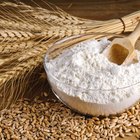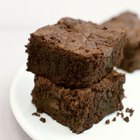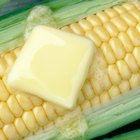
Most cake batters make cupcakes as long as you adjust the baking time for the smaller cake size. When making cake batter from scratch, the choice of flour affects the cupcake's crumb and tenderness. Flour types are categorized by the amount of protein they contain, which impacts the way that the batter performs.
Batter Chemistry
When you combine flour with wet ingredients, the protein begins to form gluten. Gluten is what makes bread dough tough, but toughness is not a desirable quality when making cupcakes. The high amounts of sugar and butter or oil in cake batter is what helps to break down the gluten.
Options
Made with soft, finely milled wheat and blended with cornstarch, cake flour has the lowest protein content of all wheat flours -- around 7 percent -- and is a natural choice for cakes. All purpose flour falls right between cake flour and bread flour with a medium protein content, meaning it's suitable for many types of baked goods. Bread flour, with its high protein content, isn't suitable for cupcakes.
Substitutions
Recipes that specifically call for cake flour have a proven formula and should be respected. To substitute all-purpose flour, use 3/4 cup of all-purpose flour plus 2 tablespoons of cornstarch for every cup of cake flour. Substituting whole wheat flour in cupcakes results in a denser cake and should replace no more than half of the white flour in your recipe. Increase your baking powder by half if substituting with whole wheat flour, and add a bit more liquid if necessary.
Techniques and Tips
When measuring flour for your cupcakes, spoon the flour into your measuring cup and avoid packing it down. Use a knife or spatula to level off the excess. If storing flour in the refrigerator or freezer, bring it to room temperature first before using it. Stop mixing your cake batter once the ingredients have combined to encourage more production of air bubbles.
Related Articles

How to Mix Cupcake Batter by Hand
What Kind of Flour Do You Use for a ...

How to Make Lactose Free Icing

How to Use Expired Cake Mix

What Are the Causes of Pie & Pastry ...

Differences Between Bleached Flour & ...

What Kind of Oil Do You Use in Brownie ...

How to Make Mexican Wedding Cookies
Can You Substitute Whole-Wheat Pastry ...
What Is the Difference Between Cake ...
Easy White Cake Recipe

Calories in a Funfetti Cake With ...

How to Make Shiny Icing for Cookies ...

Can I Substitute Bleached for ...

Can You Substitute Yogurt for ...

Butter Substitute for Molten Lava Cake

Common Food Emulsifiers

How to Substitute Cornstarch for ...
Does Cake Flour Contain Baking Soda & ...

Can You Substitute Whole Wheat Pastry ...
References
Writer Bio
For more than 10 years, Carol Butler has run a small, off-grid furniture business with her husband and is a regular contributor to the Edible community of magazines. As staff writer for RichLife Advisors, she covers financial planning and other industry-related topics. She holds a B.F.A. in theater arts.
Photo Credits
Jupiterimages/Comstock/Getty Images